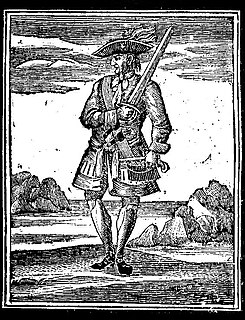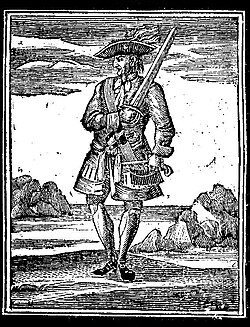
Edward Teach, better known as Blackbeard, was an English pirate who operated around the West Indies and the eastern coast of Britain's North American colonies. Little is known about his early life, but he may have been a sailor on privateer ships during Queen Anne's War before he settled on the Bahamian island of New Providence, a base for Captain Benjamin Hornigold, whose crew Teach joined around 1716. Hornigold placed him in command of a sloop that he had captured, and the two engaged in numerous acts of piracy. Their numbers were boosted by the addition to their fleet of two more ships, one of which was commanded by Stede Bonnet; but Hornigold retired from piracy toward the end of 1717, taking two vessels with him.

The earliest arrival of people in the islands now known as The Bahamas was in the first millennium AD. The first inhabitants of the islands were the Lucayans, an Arawakan-speaking Taino people, who arrived between about 500 and 800 AD from other islands of the Caribbean.

John Rackham, commonly known as Calico Jack, was an English pirate captain operating in the Bahamas and in Cuba during the early 18th century. His nickname was derived from the calico clothing that he wore, while Jack is a nickname for "John".

Mary Read, also known as Mark Read, was an English pirate. She and Anne Bonny are two of the most famed female pirates of all time, and among the few women known to have been convicted of piracy during the early 18th century, at the height of the "Golden Age of Piracy".
Captain Benjamin Hornigold (1680–1719) was an English pirate who operated during the tail end of the Golden Age of Piracy.

Anne Bonny was an Irish pirate operating in the Caribbean, and one of a few female pirates in recorded history. The little that is known of her life comes largely from Captain Charles Johnson's A General History of the Pyrates.

The Golden Age of Piracy is a common designation for the period between the 1650s and the 1730s, when maritime piracy was a significant factor in the histories of the Caribbean, the United Kingdom, the Indian Ocean, North America, and West Africa.

Charles Vane was an English pirate who operated in the Bahamas during the end of the Golden Age of Piracy.
Henry Jennings was an 18th-century English privateer from the colony of Bermuda, who served primarily during the War of the Spanish Succession and later served as leader of the pirate haven or "republic" of New Providence.
See also 1717 in piracy, 1719 in piracy, and Timeline of piracy.
See also 1719 in piracy, 1721 in piracy and Timeline of piracy.
True Caribbean Pirates is a documentary which aired on The History Channel in 2006.

The Republic of Pirates was the base or stronghold of a loose confederacy run by privateers-turned-pirates in Nassau on New Providence island in the Bahamas for about eleven years from 1706 until 1718. While it was not republic in a formal sense, it was governed by an informal pirate code, which dictated that the crews of the Republic would vote on the leadership of their ships and treat other pirate crews with civility.

The Flying Gang were an 18th-century group of pirates who established themselves in Nassau, New Providence in The Bahamas after the destruction of Port Royal in Jamaica. The gang consisted of the most notorious and cunning pirates of the time, buccaneers that would terrorise and pillage the Caribbean until the Royal Navy and infighting brought them to justice. They achieved great fame and wealth by raiding salvagers attempting to recover gold from the sunken Spanish treasure fleet. They established their own codes and governed themselves independent from any of the colonial powers of the time. Nassau was deemed the Republic of Pirates as it attracted many former Privateers looking for work to its shores. The Governor of Bermuda stated that there were over 1000 pirates in Nassau at that time and that they outnumbered the mere hundred of inhabitants in the town.
Jean Bonadvis was a French pirate active in the Caribbean. He is best known for his involvement with Benjamin Hornigold and "Calico Jack" Rackham.

Robert Deal was a pirate active in the Caribbean. He is best known for his association with Charles Vane.
Joseph Thompson was a pirate from Trinidad, Cuba, and was active in the Caribbean. He is primarily known for a single incident involving grenades.
Turn Joe was an Irish pirate and privateer who left English service and sailed for Spain instead as a guarda costa privateer in the Caribbean.

Jonathan Barnet was an English privateer active in the Caribbean. He is best known for capturing pirates Calico Jack, Anne Bonney, and Mary Read.












